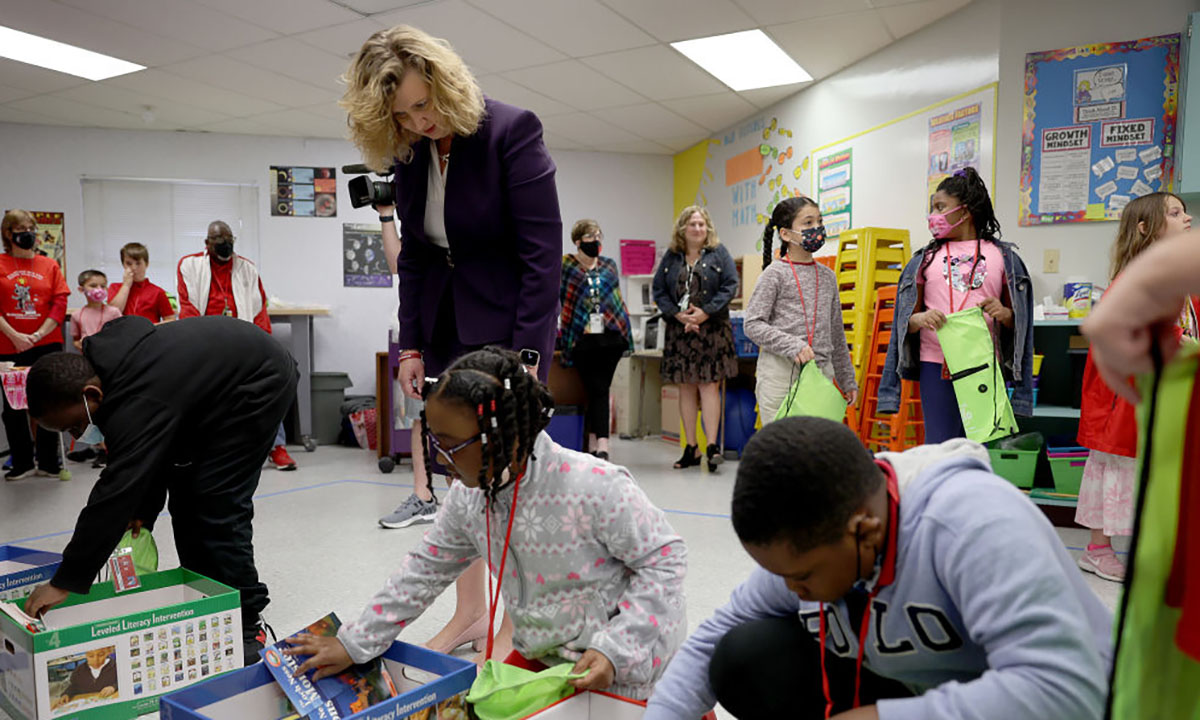Report: Half of Largest School Districts Changed Leaders Since Pandemic
The new analysis from consulting firm ILO Group shows virtually no change since 2018 in the percentage of superintendents who are women

Get stories like this delivered straight to your inbox. Sign up for The 74 Newsletter
Half of the nation’s 500 largest school districts have changed superintendents or are in the midst of a transition, according to a report tracking leadership churn since the pandemic began.
Forty-seven of those districts have seen two or more leadership changes. The turnover has been particularly hard on women: Of the 94 female superintendents who left their positions, two-thirds were replaced by men, according to the report, released Monday from ILO Group, a consulting firm that focuses on female school leaders.
“The challenges women face to get the top job are not new; they’re the systems that have been in place for generations,” said Julia Rafal-Baer, the firm’s managing partner. “With all the churn in districts happening right now, one positive outcome could have been the addition of new perspectives, but instead we are seeing the opposite.”
This is the third time ILO has published findings on superintendent turnover, which it based on news reports and press releases. Superintendent transitions are up 46% in the 500 largest districts — 228 this fall, compared to 155 in 2018. Many of the changes followed intense political strife and debate over issues such as book banning, transgender student rights and confronting issues of historical discrimination in the classroom. When there’s sudden leadership turnover, “a reset button gets hit,” said Susan Enfield, superintendent of the Washoe County School District in Reno, Nevada.
“It’s sad, it’s wrong and it’s not good for kids,” she said.
While Enfield, former superintendent of the Highline schools in Washington, is among those who left for a new position this year, it was after 10 years in the same district, which allowed for a meaningful transition.
She wishes that board members set on ousting their leaders would “understand that the superintendent store shelves aren’t chock full” of candidates who are both eager and prepared for the job.
“You will find people to move into these jobs,” she said. “But will you find the right people?”
Some of the more dramatic departures over the past year have taken place in Florida, where Republican Gov. Ron DeSantis has endorsed and replaced local board members. Moms for Liberty, a conservative advocacy organization, has also endorsed candidates in the state.
Superintendent Brennan Asplen is on his way out in Sarasota, Florida, after conservatives gained a majority in the November election. That’s despite the district’s A rating from the state and support from teachers.
Paulina Testerman, who founded Support Our Schools to counter Moms for Liberty’s influence in board elections, spoke in Asplen’s defense.
“There have been many decisions that you have made over these harrowing two years that I have personally disagreed with, but that is the definition of a good superintendent — someone who isn’t a lapdog,” she said at a Nov. 22 school board meeting. “You’re being forced out of your position … not because you were inept, but because you are not a bobble head who just nods his head.”
At the meeting, Asplen pleaded with members to “do better by your next superintendent” and to keep them from being “dragged into the quagmire of the political arena.”
Bridget Ziegler, an incumbent on the board who won re-election in November — and also co-founded Moms for Liberty —only said during a board meeting that he “needs improvement.” She did not elaborate.
While some turnover stemmed from culture war issues, parents in many communities mobilized after district leaders repeatedly pushed back reopening dates in 2021. Watching their children fall further behind in school, some left for private schools and charters, or chose to instruct their children at home.
When she looks at Sarasota, Rafal-Baer sees another issue affecting district leaders: Double standards for women. Before Asplen was hired, the board considered candidate Marie Izquierdo. They later withdrew their support when she said her husband and daughter wouldn’t relocate to the area with her if she was hired.
But when Rafal-Baer worked with Chiefs for Change, its Future Chiefs program supported four men between 2018 and 2020 who left family members at home when they relocated for jobs.
“Not one of them faced questions about their commitment, or whether they could handle the dual responsibilities of chief executive and faraway parent,” she wrote in an op-ed for The 74.
Thirty percent of superintendents are women — only one percentage point higher than in 2018, ILO’s report shows. But there are regional differences. Almost half of district leaders in the Northeast are women, compared with less than a quarter in the Southeast.
The report calls for more transparency in candidate searches. Boards and search firms, the authors write, should be required to report the qualifications and demographic characteristics of candidates, the report said.
“The combination of leadership churn and lack of representation in education leadership puts kids’ futures at risk,” Rafal-Baer said. “At a time when women are seen as decisive and trustworthy in [a]crisis, shouldn’t we be pushing hard to elevate more women?”
Get stories like these delivered straight to your inbox. Sign up for The 74 Newsletter

;)
